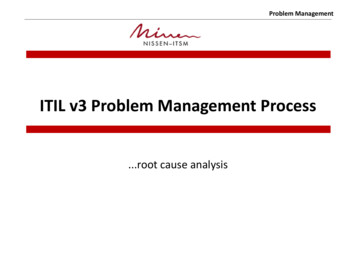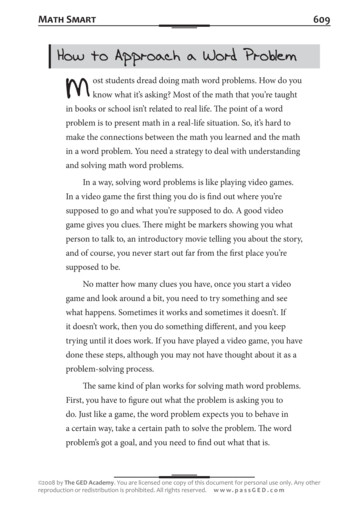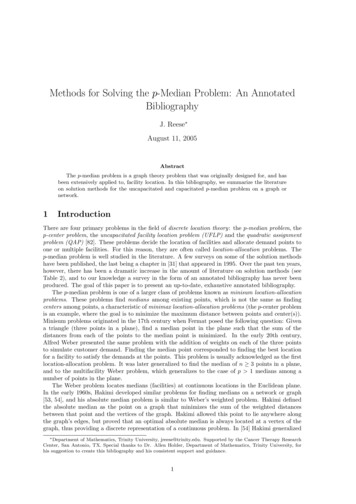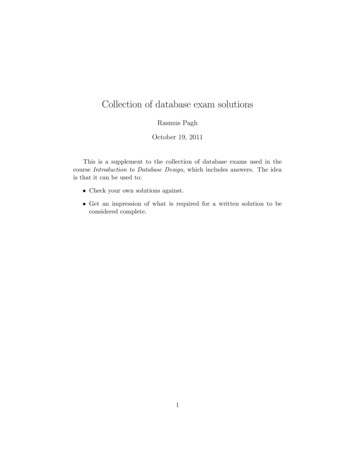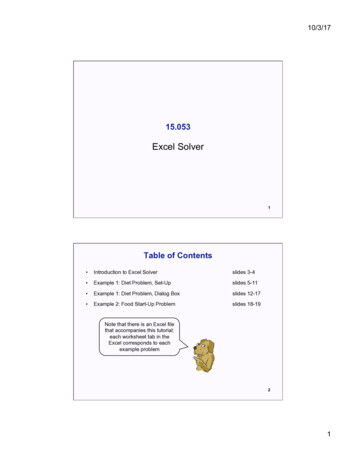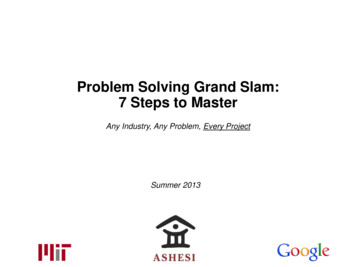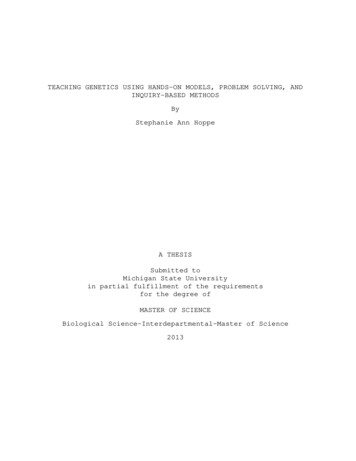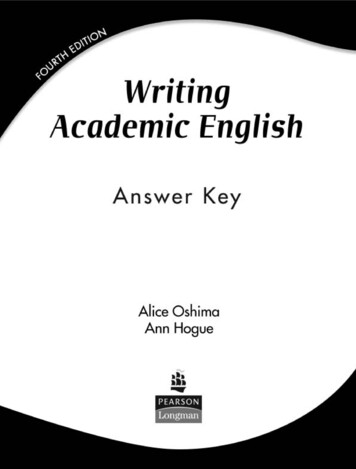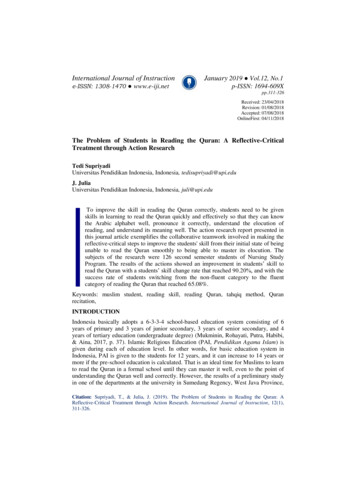
Transcription
International Journal of InstructionJanuary 2019 Vol.12, No.1e-ISSN: 1308-1470 www.e-iji.netp-ISSN: 1694-609Xpp.311-326Received: 23/04/2018Revision: 01/08/2018Accepted: 07/08/2018OnlineFirst: 04/11/2018The Problem of Students in Reading the Quran: A Reflective-CriticalTreatment through Action ResearchTedi SupriyadiUniversitas Pendidikan Indonesia, Indonesia, tedisupriyadi@upi.eduJ. JuliaUniversitas Pendidikan Indonesia, Indonesia, juli@upi.eduTo improve the skill in reading the Quran correctly, students need to be givenskills in learning to read the Quran quickly and effectively so that they can knowthe Arabic alphabet well, pronounce it correctly, understand the elocution ofreading, and understand its meaning well. The action research report presented inthis journal article exemplifies the collaborative teamwork involved in making thereflective-critical steps to improve the students' skill from their initial state of beingunable to read the Quran smoothly to being able to master its elocution. Thesubjects of the research were 126 second semester students of Nursing StudyProgram. The results of the actions showed an improvement in students’ skill toread the Quran with a students’ skill change rate that reached 90.20%, and with thesuccess rate of students switching from the non-fluent category to the fluentcategory of reading the Quran that reached 65.08%.Keywords: muslim student, reading skill, reading Quran, tahqiq method, Quranrecitation,INTRODUCTIONIndonesia basically adopts a 6-3-3-4 school-based education system consisting of 6years of primary and 3 years of junior secondary, 3 years of senior secondary, and 4years of tertiary education (undergraduate degree) (Mukminin, Rohayati, Putra, Habibi,& Aina, 2017, p. 37). Islamic Religious Education (PAI, Pendidikan Agama Islam) isgiven during each of education level. In other words, for basic education system inIndonesia, PAI is given to the students for 12 years, and it can increase to 14 years ormore if the pre-school education is calculated. That is an ideal time for Muslims to learnto read the Quran in a formal school until they can master it well, even to the point ofunderstanding the Quran well and correctly. However, the results of a preliminary studyin one of the departments at the university in Sumedang Regency, West Java Province,Citation: Supriyadi, T., & Julia, J. (2019). The Problem of Students in Reading the Quran: AReflective-Critical Treatment through Action Research. International Journal of Instruction, 12(1),311-326.
312The Problem of Students in Reading the Quran: A Reflective- Indonesia, showed that among 320 Muslim students from three batches (2016-2018), inwhich each batch consisted of three classes, there were 70% students from each classwho could not read the Quran correctly. This fact was a blow to the world of formaleducation in Indonesia, especially in PAI subjects that has direct contact with Quranreading lesson.Reading the Quran cannot be overlooked in the life of Muslims especially for thefaithful adherents. The Muslims believe that Islam is a complete way of life and givesclear direction on how to live a life and build a society (Aziz & Ambreen, 2017, p. 331).The main guidance for the Muslims is the Quran, which is then combined with theHadith as explanation and the revelation of the Quran derived from the messenger ofAllah, which is Prophet Muhammad SAW. To be able to understand the instructions inthe Quran, it is certain that every Muslim should be able to read it, and then mustunderstand the readings well and correctly as well. It means that the inability to read theQuran will have an impact on the inability to understand the Qur'an, and that could havean impact on not being able to take clues from the Quran.Reading the Quran must be correct so it needs to be done with utmost care and nomistakes (Muhammad, ul Qayyum, Tanveer, Martinez-Enriquez, & Syed, 2012). Whena Muslim in a university level cannot read the Quran correctly, then this becomes aserious problem, not only for the Muslims concerned, but also for the Islamic religion asa whole. In Islam, the Quran is a guideline to implement the Islamic Shari'a, meanwhile,one of the goals of the Islamic Shari'a is to keep the religion (Al-Shatibi, 2003). Thus, aMuslim who cannot read the Quran, is the same as a Muslim who cannot properly runthe Islamic Shari'a, so it can be called as a Muslim who has the potential to undermineIslam religion. In response to these issues, this research aims at developing students'skill in reading the Quran through reflective-critical treatments, to become fluent and tobe better in living a life as a Muslim.Some of the previous research results also seek to improve the reading skills of theQuran in various ways. Yusof, Zainuddin, and Yusoff (2011) conducted a survey toidentify the problems in reciting the Quran for Arabic speakers (Malay and Africans)and non-Arabic speakers (Malay). The results showed that there was evidence thatfluency of recitation, remembering Tajweed rules, and comprehending the words in theQuran increased with the skill to speak the Arabic language. The higher level of recitersof the Quran means the lesser problems encountered in their recitation and problemsencountered by the reciters of Quran can be reduced by increasing the general learningmethod i.e. making more effort towards learning Quran or providing the alternativemethods on learning Qur’an.This research has taken practical steps by prioritizing the direct reflective-critical action,so that the results can be examined directly. The possibility, by applying the actionsaccording to the situation and conditions that occur, can create a new method ineradicating inability to read the Quran, especially for college students or adult Muslims.It is expected that this action can establish proper and fluent basic Quran reading to theresearch participants, such as (1) reading cursive letter fluently and correctly, (2)reciting the makhraj fluently, and (3) applying the tajweed correctly.International Journal of Instruction, January 2019 Vol.12, No.1
313Supriyadi & JuliaObligation to Read and Study the Quran in IslamStudying the Quran is an obligation (Shihab, 2007) for Muslims. According to Yunus(1983), there are three important points in the purpose of learning the Quran. First,students can read the Quran fluently and correctly according to Tajweed. Second,students can get used to reading the Quran in their life. Third, students can enrich thevocabulary of beautiful and compelling words and phrases. To encourage theimprovement of skills in reading the Quran, proper learning is required. There are atleast six points that can be used as a reference for learning the Quran, which are: (1) theintroduction of Arabic alphabet in the Quran from alif to the ya; (2) makhārij al-ḥurūf,which is the guidance to the sound the alphabet and the properties of the alphabet; (3)form, function, and punctuation such as ḥarakah, shadda, sukūn, and the prolongationof the alphabet; (4) form and function of waqf (Arabic stop sign in reading the Quran);(5) the method of Quran reading and recitation of qira’at and nagham; and (6)adabuttilawah, which is the courtesy when reciting the Quran (Daradjat, 2014).There are several levels in reading Al-Quran, which are: Tartil, Tahqiq, Tadwir, andHadr. Although the way to read quickly and lightly, the matter must be in accordancewith the standards of sahīh known by qira'at experts (Syarifuddin, 2004). For beginners,first and second levels are the recommended reading levels. However, the ideal way thatneeds to be practiced in reciting the Quran according to the advice of the 'ulama istahqiq as revealed by Imam Al-Suyuti that “every tahqiq must be tartil and not everytartil is tahqiq” (Suyuthi, 2010).METHODResearch DesignThis research employs action research design. Many examples of action researchapproaches exist in educational and specifically academic library literature (Jefferson,2014; Marrow, 1977). Here, exploring a practical problem with the intention ofdeveloping a solution to the problem (Creswell, 2015) was employed. In conducting theresearch, collaborative principles especially in the application of solutions as a criticalreflective action was used. Research that employed collaborative action researchprocesses in education involve collaboration between teachers, or between teachers andresearchers (Feldman, 1999; Messiou, 2018). Collaboration in this research involved theresearchers (who were lecturers or educators of Islamic religion subject), peers who hadexpertise in music because this research used a series of melodies in the learning processof the Quran, and 10 selected students who had the skill to read the Quran at the level ofJayyid Jidan (excellent). In problem solving and development of action, in addition toobserving the learning process, the preliminary and final tests in reciting the Quran wereconducted, and training 10 selected senior students to assist in implementing anddeveloping action as supervisor (tutor).International Journal of Instruction, January2019 Vol.12, No.1
314The Problem of Students in Reading the Quran: A Reflective- Research Site and SubjectsThe research was conducted in one of the state universities located in SumedangRegency, West Java Province, Indonesia. This site was selected based on twoconsiderations, namely: (1) The researchers were the lecturers of this university; hence,it increased the feasibility of the research; and (2) It represented the Quran readingability of students in Sumedang City, Indonesia, so the results of this action research canbe used as a proposed method to teach Quran to adult students in other areas ofIndonesia. The subjects of the research were 126 second semester students of NursingStudy Program. Their place of origin was quite diverse, 121 (96.03%) people were fromSumedang Regency, 4 (3.17%) people were from Bandung Regency, and 1 (0.80%)people was from Kuningan Regency.Data Collection and AnalysisThe data were collected using several techniques, including: (1) survey instruments atthe pre-action stage to identify the Quran reading experience, the method of reading theQuran, and the motivation of learning to read the Quran; (2) observation was done toobserve the learning process of reading the Quran through the actions given; (3) semistructured interviews were conducted to elicit students' opinions about their condition inrelation to their reading skills of the Quran, and to explore their views after following aseries of actions; and (4) the Quran reading skill test was performed during pre-test andpost-test to find out the initial condition and the final result of giving the action.The Development of Quran Reading IndicatorsTo identify students' Quran reading skills, the categorizations, levels, and indicators ateach level were developed. Basically, there are five categories of reading skill, whichare: not very fluent, not fluent, substandard, fluent, and very fluent. The five categoriesare divided into five levels, which are the level of Ibtida 1 (basic 1), Ibtida 2 (basic 2),Ibtida 3 (basic 3), Jayyid (good), and Jayyid Jidan (excellent). Indicators of those fivelevels are presented in Table 1 below.International Journal of Instruction, January 2019 Vol.12, No.1
315Supriyadi & JuliaTable 1Quran Reading Skill IndicatorsLevel1.Ibtida 2.13.Ibtida 2Ibtida 3JayyidJayyidJidanKey FeaturesCannot recognize stand-alone Arabic letters with its vowelCan recognize stand-alone Arabic letters but sometimes the letters are swappedCan read the stand-alone Arabic letters but cannot read the cursive letters1. Can read the cursive letters but it is limited to 3 to 4 letters2. Can read the cursive letters but the makhraj is still wrong or swapped3. Can read the letters but slowly or haltingly1. Can read the cursive letters fluently and correctly2. The reading is not slow or haltingThe application of Tajweed is still wrongCan read the cursive letters fluently and correctly1. Can recite the makhraj fluently2. The application of Tajweed is correct3. Know a little bit about Tajweed theoryCan read the cursive letters fluently and correctlyCan recite the makhraj fluentlyThe application of Tajweed is correctUnderstand the theory of TajweedCan read the Quran with rhythmCategoryNot veryfluentNot fluentSubstandardFluentVery fluentFINDINGSPre-Action Analysis and EvaluationA total of 126 students who became the subject of research, were given surveyinstruments using Guttman scale. This survey was basically given to determine theirexperiences and perceptions of how they learn to read the Quran, their learningoutcomes, and their further desires regarding their skill to read the Quran. The results ofthe survey can be seen in Table 2 below.Table 2The Learning Experience of Reading the QuranLearning Experience of Reading the QuranHave you ever learned to read the Quran?Did you learn to read the Quran in a formal school?Did you learn to read the Quran other than in formal school?Can you read the Quran fluently?Yes12610210777No241949Table 2 above reveals that all students have learned to read the Quran, they even learn toread the Quran not only in formal school but also outside their formal school. Here, itcan also be seen that students who claimed to have been fluent in reading the Quranwere 77 (61.11%) students. In other words, the remaining 49 (38.89%) students havenot acquired the skill to read the Quran fluently. This data explained that the number ofstudents who have been fluent in reading the Quran were more than the number ofstudents who have not acquired the skill to read the Quran fluently. However, this datahas not been proven by a direct reading of the Qur'an, so that their exact level of literacyin reading the Qur'an have not been tested yet.International Journal of Instruction, January2019 Vol.12, No.1
316The Problem of Students in Reading the Quran: A Reflective- After the students' Quran reading skill based on their experience and recognition wasidentified, students were then assigned to review statements on a Likert scale. Thisassignment aims at knowing the efficacy of learning methods of reading the Quran thathave been taken by them, and the extent of their motivation or desire to learn further tobe able to read the Quran better.Table 3Quran Reading Learning MethodQuran Reading Learning MethodLearning method of reading theQuran given from elementary schooluntil high school can make studentsread the Quran fluently.Additional hours outside the formalschool should be implemented to beable to read the Quran fluently.The learning method of Quranreading outside formal school is fasterto make the students to be able to readthe Quran eryAgree34156541167238AgreeBased on the students’ statements based in Table 3, most students have agreed that thelearning method of reading the Quran given at primary and secondary level was able tomake them to read the Quran fluently. However, their statement also indicateduncertainty, as most students also agreed on the need for additional hours outside formalschool to learn to read the Quran. This was evidenced by their last statement, whichmost students agreed that the learning method of reading the Quran outside of formalschool was more effective to make them read the Quran fluently.Referring to their uncertain statements, the students’ Quran reading was tested directlyto get a clearer and more accurate insight of their skill. The Quran reading test was doneto all students (one by one) and the material was the Quran surah Shad verses 1 through15. This surah was chosen because it contains huruful muqotho’ah and is sufficientlyrepresentative to check the mastery of reading and makhraj rules. The test results provedthat 96 (76.20%) of the students could not read the Quran fluently, and the rest of the 30(23.80%) students could be categorized as a fluent reader of the Quran. Thus, this datashowed the inverse condition with the admission of students on the survey of learningexperiences of reading the Quran (Table 2), and proving uncertainty on their statementin the survey of learning methods of reading the Quran (Table 3). Through this fact, it iscertain that most students needed to be given action so that their skill to read the Qurancan develop well.Furthermore, the students were asked to return to rate the statements in Likert scale. Itaims at finding out the extent of their motivation or desire to learn further to be able toread the Quran properly and fluently.International Journal of Instruction, January 2019 Vol.12, No.1
317Supriyadi & JuliaTable 4Learning Motivation to Read the QuranLearning Motivation to Read theQuranThe skill to read the Quran fluently isvery important to master.Learning to read the Quran needs tobe done even in adulthood.Only ustadz and Muslim religiousleaders that need to be able to readthe Quran Agree102Agree142797281431Based on Table 4, it can be identified that the students had formed a strong opinion onthe importance of being able to read the Quran fluently, and the need to learn to read theQuran even in adulthood. In fact, most students also agreed that not only religiousleaders who need to be able to read the Quran fluently. They also needed to be able toread Quran properly and fluently.The result of reflection on the problems and statements of students showed that it wasnecessary to act to solve the remainder in the students’ skill of reading the Quran.Basically, they were already categorized as an adult, but considering reading the Quranis an obligation for them as Muslims, then learning to read the Quran still need to bedone even in their age. Therefore, a series of actions consisting of six stages wereperformed.Critical Actions and Evaluations on Reading the QuranPre-action analysis have resulted in six stages of learning to read the Quran. These sixstages also involve reflective-critical and practical steps in every implementation. Thefollowing presents the six stages in which each stage is accompanied by diligentobservation to observe students’ responses.Stage 1: Mapping the Quran Reading SkillsThe results from the Quran reading test clearly proved that most of the students couldnot read the Quran fluently. To find out the specific classification or the level of readingskill, then the mapping of the Quran reading skills of the students based on the results ofthe initial test of reading the Quran was done. The mapping or classification resultsshow the following data.Table 5Initial Test Results of Reading the QuranLevelIbtida 1Ibtida 2Ibtida 3JayyidJayyid 1%0.00%International Journal of Instruction, January2019 Vol.12, No.1
318The Problem of Students in Reading the Quran: A Reflective- Table 5 shows that from 126 students, students who were categorized in the fluentcategory (Jayyid & Jayyid Jidan) were 30 (23.81%) students and none of them was atthe level of Jayyid Jidan. Meanwhile, the students who were in the category of notfluent (Ibtida 1-3) were taking the highest with 96 (76.19%) students, and theclassification were: 11 (8.73%) students were on the level of Ibtida 1, 49 (38.89%)students were on the level of Ibtida 2, and 36 (28.57%) students were on the level ofIbtida 3. This clearly indicates an apprehensive condition and requires remedial actionto improve their skill to read the Quran. This condition is basically similar to the resultsof other similar research, such as Aliyah (2017) and Jamhuri (2017) research. Afterfinding out their category and level of the skill to read the Quran, the next action was tomake a classification of study groups.Stage 2: The Classification of Quran Reading Study GroupsReferring to data from preliminary test results, students’ Quran reading skills wereclassified. From the grouping result, 10 groups were formed, with each groupaccompanied by a mentor who was part of the collaboration team. The level of Ibtida 1was divided into two groups, and each group had five members. The level of Ibtida 2was divided into five groups, and each group had 10 members. The level of Ibtida 3 wasdivided into three groups, and each group had 12 members. The Jayyid level wasformed into one group, and the group had 30 members.The Ibtida 1 level group had the least members because the material was still in basiccategory and it required more attention given the skill of students in reading the Quranwas also still very basic. While the next level had more members of the group, becausethe material was not so basic and it did not need the attention of the mentor as in Ibtida1 group. It was the same with the group in the Jayyid level, because they had entered thecategory of fluent in reading the Quran, so that the number of members of the group wasmore than the other level. Students in Jayyid level were considered to be perfecting onlycertain parts of reading the Quran.Stage 3: Learning to Read the QuranStudents were taught about the pronunciation of self-disclosure non-syakal Arabicalphabets, the pronunciation of Arabic alphabets with vowels, shadda, and sukūn,reading the cursive letters, reading the words that contain alif lām qamarīyah and aliflām shamsīyah, the prolongation of the Arabic alphabets, and the theory of tajweed. ForIbtida 1 and Ibtida 2 level groups, the students were given a level 1 series bookcompiled by the researchers containing the material of self-disclosure non-syakal Arabicalphabets, Arabic alphabets with fatḥah, kasrah, and ḍammah vowels, and Arabicalphabets with tanwīn fatḥah, kasrah, and ḍammah vowels, with sukun, and withshadda. Meanwhile, the students who of Ibtida 3 level groups were given a level 2series book that contain the material of the prolongation of Arabic alphabets, nūnsākinah, waqf, qalqalah, mīm and nūn shadda, mīm sākinah, tafkhīm, tarqīq, andidghām.The learning outcomes of Ibtida 1 and 2 levels with level 1 series book took eightmeetings, and the learning outcomes of Ibtida 3 level with the level 2 series book tookInternational Journal of Instruction, January 2019 Vol.12, No.1
319Supriyadi & Juliafive meetings. Meanwhile, the students who were classified into the level of Jayyidmanaged to improve their skill within five meetings. In this learning process, there wasno self-training at home as a form of reinforcement, so some material needed to berepeated. The mentor should work harder in delivering the material in details, includinghow to exemplify pronunciation, such as practicing idghām that should contain buzzingsound. Sometimes students did not know what the humming buzz is, so it should beexemplified directly by the mentor.The problems arose in the level of Ibtida 1 and 2 students, where few students wererarely present because they felt inferior with the fact that they were still at the most basiclevel. The problem also included a small part of students that remained at the same levelas their condition in the pre-test. This was due to their very low attendance and lowmotivation so that there was no spirit to change, and their energy that was alreadydrained in the lecture sessions so that their understanding when learning the Quran wasweak. Fixed or static level positions inhibit the learning of other students. Nevertheless,most students succeeded in increasing their learning motivation so that they succeededin improving their skill to read the Quran.Stage 4: Habituation and Memorization of Reading the QuranStudents were given pronunciation exercises to familiarize in pronouncing makhraj byusing syllables as follows:Example 1. Arabic alphabet Alif أَاِأ ُ بــَـــأ ْ أَاِأ ُ بــَـــأ ْ أَاِأ ُ بَـــــأ ْ ا ُ ْوأ ً ا َ ِن أَأْ نَ مِ نَ اْلـ ُمؤْ ِن َمئِ ْيأ ً ا َنـ ِئًا Example 2. Arabic alphabet Ba ب بُ بَبْ بُ ْوبً بَ ِن بَبـْنَ مِ نَ ْال ُمبـْ ِن َمبِ ْيبً بَنِبًا ِ ب ِ ب ِ ب َ ْ ب بُ بَب َ ْ ب بُ بَب َExample 3. Arabic alphabet Taْ ت تُ َب ْ ت تُ َب ْ ت تُ َب ت ت ُ ْوتً ت َ ِن ت َتـْنَ مِ نَ ْال ُمتـْ ِن َمتِ ْيتًا تنِتًا ِ َ ت ت ِ َ ت ت ِ َ ت The red letters were unchanged letters in every word phrase sequence, it is just adjustingthe way their pronunciation with the letters that are trained. For example, in the exerciseof letter of ا - letter of ( ب the first red letter) it will be read as ba, in the exercise of theletter of ب it will be read bab, and in the exercise of the letter of ت it will be read bat,and so on. Meanwhile, the black letters were changing according to the sequence of theArabic alphabet. In other words, after the three examples of the letters above, thehabituation in pronouncing the makhraj will be followed by the onward Arabic alphabetfrom the letter of ا until the letter of ي .All syllables that are spoken, were trained by using melodies to make it easier toremember because the melody of a song can facilitate learning and recall (Konantz,2012; Wallace, 1994). The following melodies were sung in learning to pronouncemakhraj:International Journal of Instruction, January2019 Vol.12, No.1
320The Problem of Students in Reading the Quran: A Reflective- Figure 1The melody of Arabic alphabet AlifFigure 2The melody of Arabic alphabet BaThe melody in Figure 1-2 are a series of melodies commonly used in some boardingschool or in Quran learning center for children especially in the province of West Java,Indonesia, with the same function as in this research, which is to train learners to quicklyremember and properly pronounce the makhraj. This method was effective in improvingthe learner's skills in pronouncing makhraj, as it has been experienced by the researchersthemselves. So as in this research, through practice with syllables and melodies above,students could remember more quickly and able to distinguish the similar but not thesame in pronunciation techniques Arabic alphabets. For example, the Arabic alphabet of س with ش and ث , the Arabic alphabet of ح with خ and هـ , the Arabic alphabet of ا with ع ,the Arabic alphabet of د with ذ , and the Arabic alphabet of ض with ظ .Stage 5: Examination and Strengthening the Quran Reading SkillThe teaching team conducted examination of students’ skill in subtest form on eachmaterial given before final or posttest. The objective was to observe the mistakes inimplementing the reading rules that appears when they read the Quran, and to be furtherrectified and reminded. Each mentor conducted tests to students by directly reading theQuran with different surah. The results of the examination show that the results varyaccording to the level of students’ skill in reading the Quran. For example, for thestudents in the level of Ibtida 1, when they were being tested, they were already able toread the cursive letters, but still stuttered. For the students in the level of Ibtida 2, theycould read the cursive letters fluently, but the application of Tajwid was still wrong.Then, for the students in the level of Ibtida 3, they could read the Quran fluently and thereading had been accompanied by the right application of the Tajwid, but the theory ofTajwid are not yet fully mastered.Based on the results of the investigation, several actions were carried out. For example,for students who were still pronouncing the makhraj wrong, they were reinforced withpronunciation practice through imagery techniques. For example, the sound of ح waslikened to the sound of ha in the word "Hug". It is the same for students who wereInternational Journal of Instruction, January 2019 Vol.12, No.1
321Supriyadi & Juliacategorized in basic level. They sometimes forgot the form of letters, so they were beingreminded through symbols. For example, the letter ا is symbolized with a pole, the letter ت ث ب are symbolized with a bowl, the letter خ ح ج are symbolized with a chicken,letters ظ ط are symbolized with coconut buds, letters س is symbolized with toothbrush,and the letter ل is symbolized with a hook. This symbolization is enough to help studentsin reinforcing their memories of the Arabic alphabets.Stage 6: The Final Test of Reading the QuranAll students who had followed the learning stages of reading the Quran, both who werealways present and rarely present, were tested again for their progress in reading theQuran. The final test was performed and assessed directly by the researchers. The testresults show the following data.Table 6The Final Test Results of Reading the QuranLevelIbtida 1Ibtida 2Ibtida 3JayyidJayyid 23.81%Table 6 above depicts that there was a progress of students' skill in reading the Quran.This significant progress can be seen in the number of students who entered the fluentcategory of reading the Quran (Jayyid & Jayyid Jidan), which amounted to 82 (65.03%)students, with 52 (41.27%) students were classified at the level of Jayyid, and 30(23.81%) students were classified at the level of Jayyid Jidan. Meanwhile, students whoentered the category of not fluent in reading the Quran (Ibtida 1-3) were amounted to 45(35.71%) students. The numbers of students that entered the category of not fluent inreading the Quran was still quite a lot. However, students’ skill level specificallyimproved, because the numbers of students who could read the Quran fluently weremore than the one who could not read the Quran fluently. The changes of the students’skill level are depicted in Figure 1 below.International Journal of Instruction, January2019 Vol.12, No.1
The Problem of Students in Reading the Quran: A Reflective- 322Improvement in Students' Quran Reading Skill6040200Ibtida 1Ibtida 2Pre-TestIbtida 3Post-TestJayyidJayyidJidanProgressFigure 3The Graph of Improvement in Students' Quran Reading SkillFigure 3 above depicts a change in the level of students' skill to read the Quran. Theresults of pre-test and post-test proved that students at Ibtida 1 level were reduced
identify the problems in reciting the Quran for Arabic speakers (Malay and Africans) and non-Arabic speakers (Malay). The results showed that there was evidence that fluency of recitation, remembering Tajweed rules, and comprehending the words in the Quran increased with the skill to speak the

